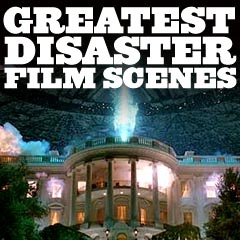
|
Film Scenes 1990s |

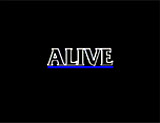
|
Alive (1993) Director Frank Marshall's notorious, adventure docudrama survival film was based on the 1974 novel of the same name, "Alive: The Story of the Andes Survivors," by Piers Paul Read. Other similar survival films in various settings were: The Flight of the Phoenix (1965), Marooned (1969), The Poseidon Adventure (1972), Cast Away (2000), Open Water (2003), Into the Wild (2007), 127 Hours (2010) and The Martian (2015) - to name just a few. The true-to-life story, told in flashback, was about a Uruguayan rugby team whose Air Force plane (Flight # 571) crashed in the Andes Mountains in the fall of 1972. The film's tagline expressed:
The film opened with the spectacular airplane crash into the mountain range (prefaced by one passenger's question: "Are we supposed to fly that close to the mountains?"). The plane first clipped off its tail-section and wings, sending a few passengers strapped in their seats to their deaths from the back of the plane. The rest of the heavily damaged fuselage skidded down a steep snowy embankment before it came to rest. There followed weeks (over two months) of struggle, death and survival in sub-zero temperatures. The group was forced to resort to cannibalism to survive in the twisted wreckage of the fuselage. Eventually, after a treacherous 12-day trek down the mountain by Nando Parrado (Ethan Hawke) and Roberto Canessa (Josh Hamilton), rescuers were alerted. Helicopters returned to the crash site and found 14 other survivors. In total, there were 29 dead and 16 survivors. |
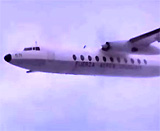 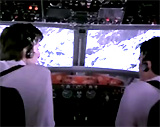 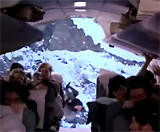 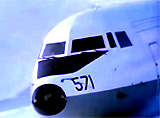
|
||||
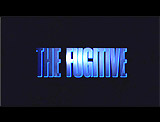
|
The Fugitive (1993) This popular Best Picture-nominated action film from director Andrew Davis received seven Academy Award nominations (with only one win), including Best Cinematography, Best Film Editing, Best Original Score, Best Sound, and Best Sound Effects Editing. Its most exciting sequence recalled another train crash found in Cecil B. DeMille's Best Picture-winning film The Greatest Show on Earth (1952). It was based upon Roy Huggins' exciting, episodic ABC-TV series from 1963 to 1967, starring David Janssen as the wrongly-accused fugitive doctor, Dr. Richard Kimble, who was relentlessly pursued for the murder of his wife by the authorities, led by Police Lieutenant Philip Gerard (Barry Morse). Meanwhile, the real one-armed killer (Bill Raisch) was on the loose. The main disaster-related sequence in the feature film began with the crash of a CORRECTIONS bus on a highway, transporting prisoners - including the "fugitive" character, Dr. Richard Kimble (Harrison Ford), to death row. Fellow prisoners were executing an escape attempt, that caused the bus to crash into a guard rail, roll down a steep road-side ravine, and settle on railroad tracks - in the path of an oncoming train. When the train, that was attempting to brake and sounding its siren, slammed into the middle of the bus, it sent the flaming metal carcass skidding along the tracks. Kimble successfully jumped clear of the initial collision, but with his feet still shackled, he had to dodge part of a derailed train car that was still aimed straight at him. Deputy Samuel Gerard (Best Supporting Actor Oscar-winner Tommy Lee Jones), who was in pursuit of the fugitive, commented upon the wreckage when he first drove up to the scene:
|
 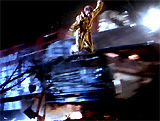 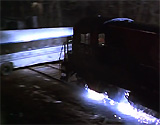 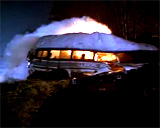 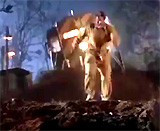
|
||||
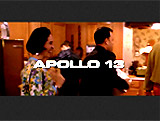
|
Apollo 13 (1995) Director Ron Howard's blockbuster hit (with nine nominations and two wins - Best Sound and Best Film Editing) was a chronicling of the real-life adventures of the ill-fated, heroic astronauts (mission leader Jim Lovell and his crew) on the 1970 Apollo-13 mission to the moon (the third such NASA mission). Commander Jim Lovell (Tom Hanks) averted tragedy with the persistent help of the Houston NASA team, led by chain-smoking flight director Gene Kranz (Ed Harris). The central scene of the disaster in space was conveyed by Command Module Pilot "Jack" Swigert's (Kevin Bacon) and Lovell's famous quotes. Swigert had just turned on the liquid oxygen tank stirring fans as he was commanded:
[Lovell's line has often been misquoted as: "Houston, we've got a problem" - the line in the film actually spoken by Swigert. However, Lovell's quote in actuality was "Houston, we've had a problem" - basically a restatement of the line first delivered by astronaut Swigert in the real-life catastrophe: "Hey, Houston, we've had a problem here."] The main problem was the explosion of one of the oxygen tanks, that severely crippled and damaged the crew's Service Module, and made it almost impossible to return home safely. |
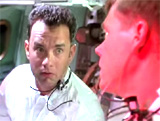 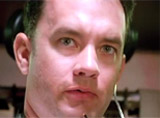
|
||||
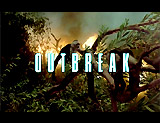
|
Outbreak (1995) Director Wolfgang Petersen's disaster film (about a major medical emergency regarding deadly viruses and a race against time to prevent an end to the world) was based upon Richard Preston's best-selling 1995 non-fiction novel titled "The Hot Zone: A Terrifying True Story." Its tagline was:
The plot was introduced in a short prologue that told about a deadly, Ebola-like, monkey-borne virus (called Motaba) from Zaire in Africa, that had originally appeared in 1967 (but was fire-bombed out of existence). It re-emerged in the mid-1990s, and spread to the US through an illegally-smuggled infected animal - a white-headed capuchin monkey named Betsy. The deadly airborne virus spread in a small fictional Northern California town (Cedar Creek). The first three to be infected by monkey bites (and expire) were:
The spread of the highly-contagious virus was first monitored by CDC scientist Dr. Roberta Keough (Rene Russo) in Atlanta, and by infectious disease expert Colonel Sam Daniels (Dustin Hoffman) (Roberta's ex-husband) in Maryland (at the US Army Medical Research Institute of Infectious Diseases (USAMRIID)), with his colleague Lieutenant Colonel Casey Schuler (Kevin Spacey). One digital effects sequence effectively demonstrated how the virus could quickly spread by a sneeze (and its particle-filled viral spray) in a crowded movie theatre. The contagious outbreak of the virus was also demonstrated on a map of the US - filled in by a red color (within 48 hours). Soon, intrigue and suspenseful tension were raised when the military, led by Major-General Donald McClintock (Donald Sutherland), threatened to bomb the small California town to eradicate the illness (known as Operation Clean Sweep) - the same technique used in the mid-1960s. Daniels worked feverishly to prevent the disease's viral spread by quarantine measures, to locate Betsy, to develop an antidote, and to save both infected Keough and Schuler (who died). A military coverup, helicopter chases, and efforts to spare the bombing of the town sidetracked the remainder of the film. |
 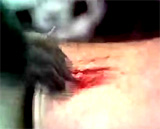 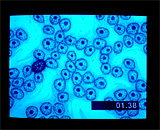 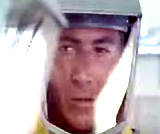 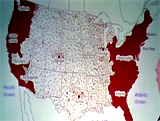 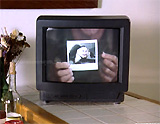 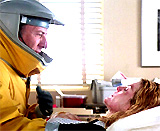
|
||||
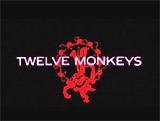
|
Twelve Monkeys (1995) (aka 12 Monkeys) Director Terry Gilliam's sci-fi fantasy about time travel and a devastating plague (caused by a deadly pathogen) was a remake of Chris Marker's short film La Jetée/The Pier (1962, Fr.). The city of Philadelphia in the dystopic years of 1996-1997 was snow-covered, plague-ridden, and overrun with wild animals (bears, lions, etc.). The tagline for the film was related to the plot:
Mentally-unstable prison convict James Cole (Bruce Willis) was sent back in time from the virus-plagued, post-apocalyptic world of 2035 to 1996 (but he first detoured to Baltimore in 1990), to observe the past and collect information - and possibly create a better future. In exchange for being pardoned, his mission was to obtain a pure sample of the horrible virus that had killed 5 billion people and forced humanity to live underground for many decades (the surface of the Earth was unliveable although wild animals roamed around), so that a cure might be found.
The character of insane, eccentric animal activist Jeffrey Goines (Oscar-nominated Brad Pitt), incarcerated in a mental institution in Baltimore in the year 1990, was associated with a radical group known as "The Army of the 12 Monkeys," but it was not, as universally alleged, that the group had unleashed a worldwide plague virus (in December of 1996) that killed five billion people and made Earth unlivable. The group was instead just "a bunch of dumb kids playing revolutionaries" who freed wild animals from Philadelphia's Garden Zoological Society. In the slightly-optimistic conclusion, red-haired, pony-tailed bio-terrorist and "apocalyptic nut" Dr. Peters (David Morse), an assistant in the laboratory of Jeffrey's famous virologist father Dr. Leland Goines (Christopher Plummer), was about to embark on a worldwide tour beginning at the Philadelphia airport. In the security line, he had just exposed the security guard and himself to the virus by opening up his carry-on suitcase that contained vials of live samples of the deadly virus. He was able to avoid being detained during a shooting and was seated on an airplane (bound for San Francisco). Next to him was a woman who introduced herself as Jones (Carol Florence): "I'm in insurance." She was one of the female scientists from the future year of 2035 who had been guiding Cole's time travels. It was a hopeful sign that she would retrieve a pure sample of the virus (and/or be exposed) and bring it back to the future as a backup plan to help save the world by finding a cure. |
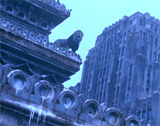 Plague-Infected City of Philadelphia in the Year 2035, Overrun with Wild Animals  Animal Activist Jeffrey Goines (Brad Pitt) With Cole (Bruce Willis) in a Baltimore Mental Asylum in 1990 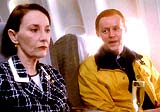 In Late 1996 at the Philadelphia Airport, Crazed Dr. Peters on a Plane Next to Female Scientist "Jones" (Carol Florence) From 2035 |
||||
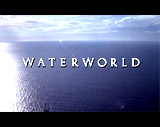
|
Waterworld (1995) Kevin Costner (who co-produced and took over the directing reins mid-stream after firing director Kevin Reynolds) headlined this action-packed science-fiction film as an anti-hero. In part, the film superficially resembled The Road Warrior (1982) (aka Mad Max 2 (1981, Australia)) and Blade Runner (1982), due to its post-apocalyptic view of Earth after global warming. Sometime in the 21st century, the polar ice caps had completely melted (seen in an animated graphic), causing the rise of sea levels and the submergence of all of Earth's land masses up to 25,000 feet. The narrator (Hal Douglas) described the massive climactic change during the opening:
The central plot of the film (presumably around the year 2,500 AD) pitted two opposing forces:
He had rescued love-interest and atoll barmaid Helen (Jeanne Tripplehorn) and her adopted daughter named Enola (Tina Majorino) who possessed a tattoo on her back of a map that identified the location of Dryland - the world's paradisical (or mythological) last continent. As the film concluded, it was revealed that Dryland actually existed - it was the top of Mount Everest! |

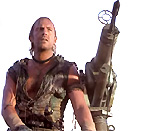 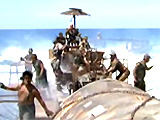 |
||||

|
Daylight (1996, US/UK) Director Rob Cohen's formulaic disaster-action thriller (filmed largely in Rome, Italy at Cinecitta Studios), with only one Academy Award nomination for Best Sound Effects Editing, was advertised as:
A traffic accident in the Holland Tunnel involved trucks carrying dangerous loads of illegal toxic waste and diamond thieves in a getaway car. The crash triggered a massive explosion and fireball that raced through the entire tunnel. It caved in and sealed off both ends of the tunnel under the Hudson River in New York City. Cab driver Latura (Sylvester Stallone), the disgraced former chief head of Emergency Medical Services in NYC was also about to drive into the tunnel. Alerted to the catastrophe, he entered the tunnel through the air shafts of the exhaust ventilation system to try to survey the damage and help prepare a rescue operation ("Get them back to daylight"). He was assisted by:
There were a number of trapped and seriously-injured civilians inside the tunnel, all inevitably threatened by death through many means: suffocation, fire, flooding (drowning), hypothermia, or crushing. There was also a scene of rats swarming toward the trapped individuals. The survivors (many of whom died during rescue efforts) included:
|
 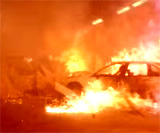 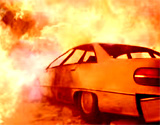 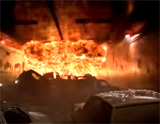 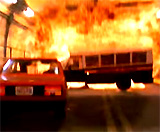 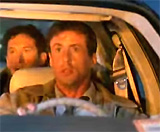 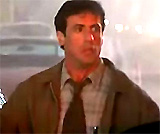
|
||||
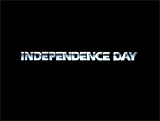
|
Independence Day (1996) Director/co-writer Roland Emmerich's blockbuster doomsday sci-fi film, unofficially, was a remake of the original 1950s alien attack film The War of the Worlds (1953). It revived the tradition of disaster films having a large-scale cast. It garnered only two Academy Award nominations, including Best Sound, and was the winner of the Best Visual Effects Oscar (defeating Twister (1996)). It told of alien invaders in early July of 1996 overtaking the Earth, in order to harvest the planet's natural resources. Doomsday for the world was signaled by a monstrous, asteroid-sized UFO (mothership) that entered Earth's atmosphere and hovered over the skyline of NYC, and other major cities. Although evacuations were approved by the US President Thomas J. Whitmore (Bill Pullman), of New York City, Los Angeles, and Washington DC., they proved to be too late. It included well-publicized images of the White House and Capitol Building being destroyed. Counter-attacks by fighter squadrons (of the US military) (and even fired nuclear missiles) against the alien destroyer ships (hovering over the devastated cities) proved ineffectual. However, in one instance, Captain Steven Hiller (Will Smith) was able to force the crash of an alien-ship in the Grand Canyon and capture the injured alien pilot for testing, questioning and examination. Everyone fighting the immense, large-scale threat converged in the Nevada desert, in an area known as Area 51, where there had been rumors of extra-terrestrial aliens dating back to 1947. The individuals working together included:
It was decided, as in the original 1953 film, to capitalize on the aliens' one known vulnerability - to infect them with a virus uploaded into the mothership, and thereby deactivate the force field around the ship. The film concluded with a patriotic, flag-waving counterattack on July 4, Independence Day in the US, prefaced by President Whitemore's rousing speech:
The threat was eliminated when Vietnam vet pilot Russell Casse (Randy Quaid) flew his plane kamikaze-style into the weapon port of the mothership to destroy it ("Do me a favor. Tell my children I love them very much. All right, you alien assholes! In the words of my generation, up yours!...(to the aliens) Hello boys! I'm back!"). |
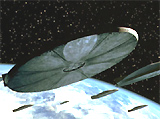 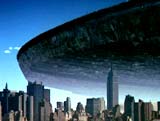 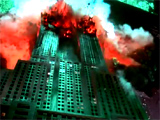 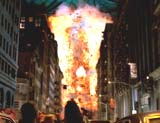 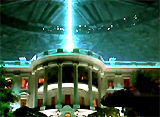 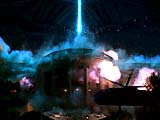 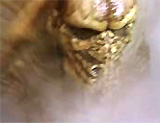 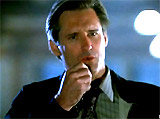 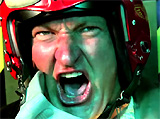
|
||||

|
Twister (1996) Director Jan de Bont's blockbuster disaster film, with an enormous budget of $92 million, told about storm chasers, meteorologists and weather researchers who pursued deadly tornadoes. The big-budget film was the recipient of only two Academy Award nominations: Best Sound and Best Visual Effects. It was also notable as the first Hollywood feature film to be released on DVD. It became the second biggest film of the year, behind only Roland Emmerich's Independence Day (1996). The main team of twister-chasing, thrill-seeking researchers were:
Bill and Jo planned to use a sensing, data-gathering device that they had co-invented nicknamed DOROTHY, that was to be released in the vortex of the tornado, to record data from sensors. They were competing with another group of rival storm chasers, led by corporate-funded Dr. Jonas Miller (Cary Elwes), who was plagiarizing Jo's sensor device with his own sensor called DOT-3. State of the art, digital special effects and computer graphics included cows flying through the air along with other large objects, such as houses, other vehicles, and farm equipment. |
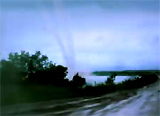 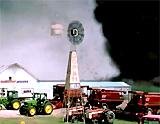  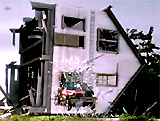
|
||||
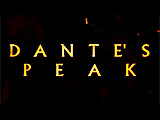
|
Dante's Peak (1997) Although formulaic and cliched, director Roger Donaldson's dramatic thriller was the better of the two competing volcano disaster films in 1997 (see also Volcano (1997) below). Its tagline was:
It told about a small, rural Pacific Northwest town in Washington state named Dante's Peak that was threatened by unusual seismic activity - signs of an impending erupting volcano. The town was rated as a desirable and booming tourist destination, but news of a possible disaster would most certainly hurt commercial interests and business revenue - similar to the situation facing Amity Island's vacationers and the mayor in Jaws (1975). The main characters involved in the natural disaster (and a growing love affair), the eruption of a dormant stratovolcano in the Cascade Mountains, included:
[Note: As backstory, Dr. Dalton lost the love of his life, Marianne (Walker Brandt), in an earlier sequence set in Colombia during a volcanic event. As his passenger, she was crushed by a lava rock hurled at their truck's compartment.] Warnings of the impending disaster in Dante's Peak were noticed (after evidence of dead plants and wildlife (squirrels), a hot springs that boiled two people, and contaminated water) - with little effect, until the evidence of a smoking crater, lava flows, explosions, massive ash clouds, and sulfuric-rich water (causing chemical burns) were seen as really threatening. Rivers of raging mud (caused by melting glaciers), showers of molten rock and lakes of lava, and a collapsed dam hindered death-defying attempts at evacuation and escape with assistance from the National Guard. Taking shelter in an abandoned mine left Harry, Rachel, and her children trapped when the mine collapsed, although their beacon alert signal eventually brought a rescue crew. |
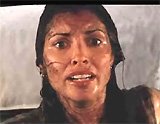 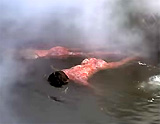 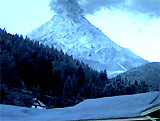 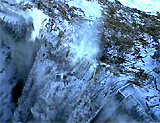  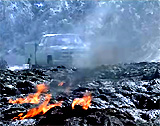 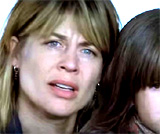 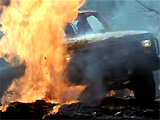 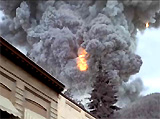 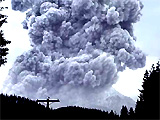
|
||||
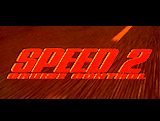
|
Speed 2: Cruise Control (1997) Director/producer Jan de Bont's race-against-time action thriller and disaster film was his follow-up to Speed (1994), after his most recent film Twister (1996). It was considered a box-office flop and also an unthrilling effort. From its eight Razzie Awards nominations, it earned the Razzie Award for Worst Prequel, Remake, Rip-off or Sequel. The two main stars in a romantic relationship, experiencing a Caribbean cruise together on the Seabourn Legend, were:
The villain was John Geiger (Willem Dafoe), a copper-poisoned, vengeful wacko, the disgruntled original designer of the ship's computer system, who hijacked the cruise ship with his laptop computer. After murdering the ship's captain, his plan was to steal valuables in the ship's vault (stored there by a diamond dealers' association) after evacuating the ship. The first planned catastrophe was to ram the ship into an oil tanker off the coast of Saint Martin. Alex was able to divert the ship from a direct hit, although the out-of-control cruise liner was now aimed at the wharf-marina area of a Caribbean resort town. The film's most expensive sequence - and one of the largest and most expensive stunts ever filmed, was the liner's slow crash through a pier and a couple of buildings in the resort harbor town. In the exciting conclusion, Alex rescued Annie - taken as a hostage on Geiger's seaplane, just before Geiger was killed in a huge explosion when the plane crashed into the oil tanker. |
 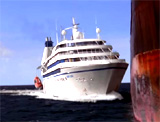 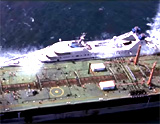 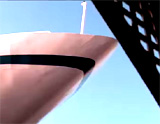 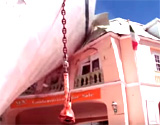 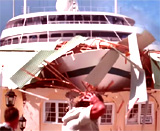 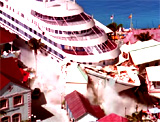 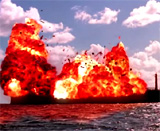
|
||||
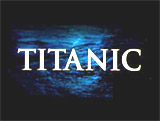
|
Titanic (1997) Writer/director James Cameron's Best Picture-winning masterpiece of historical accuracy chronicled the tragic sinking of the White Star Line's $7.5 million R.M.S. Titanic in the Atlantic on its maiden voyage on April 15, 1912. One of the most popular films of all-time (and most expensive), the romantic epic and sea adventure grossed over a billion dollars worldwide, and featured complex, state of the art digital effects, models, live-action and miniatures. The blockbuster was nominated for 14 Academy Awards, and the winner of eleven Oscars, including Best Picture, Best Director, Best Visual Effects, Best Sound, Best Sound Effects Editing, Best Film Editing, and Best Cinematography. The disaster began to occur after the "unsinkable" ocean liner collided with an iceberg. As water began to fill compartments in the front of the ship, some of the passengers were able to board lifeboats (with a "women and children first" policy), but many passengers were left on the deck. When the ship broke in half and began to tilt, ever increasingly into a vertical position before plunging downward, a number of passengers fell to their deaths. A large number of survivors froze in the frigid waters or drowned in the flooded ship, creating a frozen corpse field. Before and during the tragedy, a vicious love triangle developed between penniless Jack Dawson (Leonardo DiCaprio), society girl Rose DeWitt Bukater (Kate Winslet), and her wealthy fiancee Cal Hockley (Billy Zane). The romance took a back seat to the powerful visuals and drama of the sinking. |
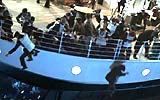 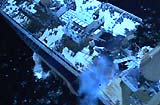 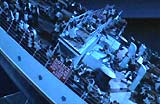 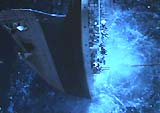
|
||||

|
Volcano (1997) Director Mick Jackson's contrived, big-budget disaster film (without Academy Award nominations) was in competition with a similar action-thriller disaster film that was more popular at the box-office -- Dante's Peak (1997) (see above). Its taglines were:
Everything centered on the efforts of Mike Roark (Tommy Lee Jones), Los Angeles' strict director of the office emergency management (OEM) and his associate Emmit Reese (Don Cheadle) to stem the tide of disaster. Following an earthquake and the release of hot steamy gases that killed a number of underground utility workers, there were signs that a massive volcanic event was about to happen. Warnings by smart geologist Dr. Amy Barnes (Anne Heche) were not heeded. The title was somewhat of a misnomer -- rather than a typical conical volcano, it told about an underground volcano with a lava vent (at the La Brea Tar Pits) that flooded Los Angeles (in the heart of West Hollywood) with rivers of destructive lava (magma), and the spewing of red-hot lava bombs. In one harrowing rescue scene of a derailed Red Line train driver, hapless LA MTA Chairman Stan Olber Stan (John Carroll Lynch) self-sacrificially drowned in a sea of lava. The main efforts to stop or divert the flow were to barricade the city (with concrete barriers and explosives) against the slow-moving menace, with appropriate pyrotechnic special effects - including raining lava. There was an impressive tower of lava outside of the Beverly Center. Eventually, after the loss of many lives, the lava was directed toward the ocean. However, the film's epilogue - four lines of text, warned of future trouble (and a possible sequel):
|
   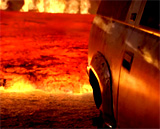 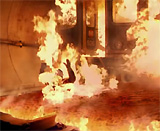 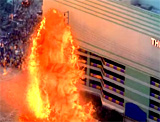 
|
||||

|
Armageddon (1998) Director Michael Bay's science-fiction space-related disaster thriller (produced by Jerry Bruckheimer), with an unrealistic, mostly-unscientific premise, was a typical large-scale epic with an ensemble cast and great special effects. The credits even included the disclaimer:
Its tagline threatened:
The fast-paced, loud film received four Academy Award nominations (with no wins): Best Sound, Best Sound Effects Editing, Best Song, and Best Visual Effects (defeated by What Dreams May Come (1998)). Notably, it was the more successful of the two competing doomsday "killer asteroid" films of 1998, the other being Deep Impact (1998) - see below. In the other disaster film, preparations were similarly made to destroy a huge, deadly comet set to collide with Earth, after splinters of the meteorite hit New York City. In this one, about an impending "global-killer" asteroid set to cause Armageddon in about half a month, a team of blue-collar, misfit deep-core miners were trained for 12 days and then sent by NASA (coordinated by its director Dan Truman (Billy Bob Thornton)) to race into space. Their objective was to plant nuclear explosives on the approaching gigantic meteor (800 feet within the asteroid), to split it apart and divert the main pieces away from directly hitting Earth. A massive, mobile tank-like drilling rig known as the 'Armadillo' would be employed, as well as two shuttles to guarantee success. The main cast members (mostly crew) included:
At the start of the film, the first signs of trouble came when the NASA satellite shuttle Atlantis repair crew was hit by a shower of space meteorite debris. Then, other larger asteroids caused major damage in New York City (including landmarks such as Grand Central Station and the Chrysler Building), before it was determined that the largest comet was aimed at Earth and could cause extinction. Like Meteor (1979), it featured now-disturbing imagery of a damaged World Trade Center -- and rogue meteors caused the complete destruction of Paris and Shanghai and other places, with bombardments of rock and tsunamis. |
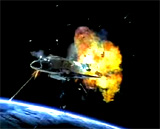  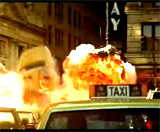 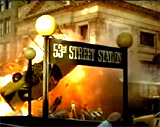 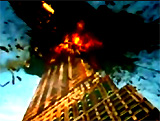 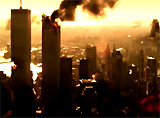 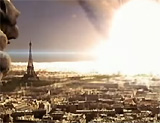
|
||||
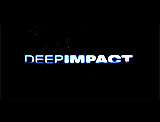
|
Deep Impact (1998) A more philosophical, introspective, scientifically-accurate, and character-driven existential film than Armageddon (1998), director Mimi Leder's sci-fi disaster film had a similar premise. Its taglines were:
It also told about a 7 mile-wide comet (nicknamed Wolf-Biederman) that was on a collision course with Earth in about a year's time. A top-secret joint effort was conducted by the US and Russia to construct an Orion spacecraft (Messiah), that would transport astronauts to the approaching comet, so it could be diverted with a nuclear explosion and thereby prevent apocalyptic destruction (an "Extinction-Level Event" or L-E ("Ellie")). The team members included:
The Messiah's rescue effort to drill into the comet and place a nuclear warhead to destroy or change the path of the comet failed. The nuclear explosion formed two comet splinters (1.5 and 6 miles wide), that were still headed for Earth. To ensure that the human species would survive, the government had developed an underground survival shelter in Missouri (a type of Noah's Ark) for a select group (determined mostly by lottery) of about 1 million individuals, including some early picks:
The smaller comet fragment (nicknamed Biederman) struck the East Coast of the US, and caused a massive tidal wave/tsunami 350 feet tall that devastated New York City and other coastal cities and areas. The megatsunami covered the entire city, except for the tops of the World Trade Center. There was an impressive shot of the Statue of Liberty's head underwater and bouncing down Wall Street. The larger fragment (nicknamed Wolf) was due to hit western Canada, where its impact would create a 'nuclear winter' - a dense cloud of dust that would inevitably block the Sun and cause extinction. The remaining crew of the Messiah decided to go on a heroic suicidal mission to destroy Wolf by inserting the remaining warheads into one of the comet's vents. They were able to destroy it with nuclear missiles before 'deep impact.' |
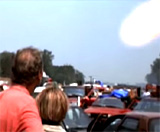 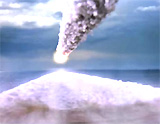  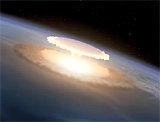 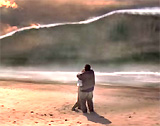 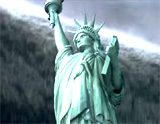 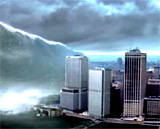 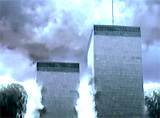 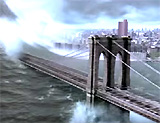 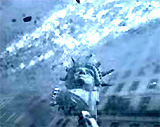
|
||||
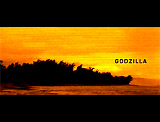
|
Godzilla (1998) Director Roland Emmerich's creature-feature, sci-fi-action-horror-disaster film, the first completely produced by a Hollywood studio, followed after its original Japanese predecessors (and lots of spin-offs) - and before another Hollywood-made sequel in 2014:
Although this remake was a box-office success, it was not well-received by critics. For example, it received two Razzie Awards: Worst Remake or Sequel, and Worst Supporting Actress (Maria Pitillo). Its tagline was:
As in the other earlier Japanese versions, Godzilla was spawned from atomic nuclear tests in the South Pacific (French Polynesia) in the 1940s and 1950s (shown in historic newsreel footage). The enormous sea creature was a mutation of affected island-dwelling lizards after irradiation. The first to seriously be called upon to study the phenomena of giant footsteps, reports of a huge reptile (possibly Gojira) and devastation were biologists and researchers:
There was two unnecessary sub-plots: the first about covering-up responsibility for the nuclear testing by French secret service agent Philippe Roache (Jean Reno), and second, a romantic angle involving Niko's ex-girlfriend Audrey Timmonds (Maria Pitillo) - a problematic, overly-ambitious, aspiring TV news reporter. The mutated monster eventually ended up in New York City, where military forces were assembled to battle the beast as it rampaged through the streets between towering skyscrapers (and knocked off the top of the Chrysler Building). It was determined that Gojira was searching for food for its offspring, located in a nest (with 200 eggs) inside Madison Square Garden. An F-18 airstrike bombing of the arena eliminated the threat of hatched eggs, although the adult mother still needed to be destroyed. Godzilla was successfully dispatched by trapping the creature in the suspension cables of the Brooklyn Bridge, and then blasting it with fire-power from Air Force jets in a final showdown. It died, collapsed and the full weight of its gigantic head crushed a taxi. A sequel was made possible by the final shot - one surviving egg hatched in the Arena - and the baby roared at the camera before the end credits. |
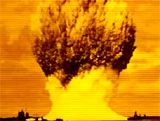 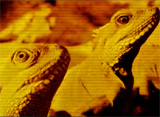  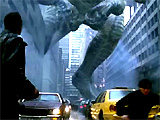 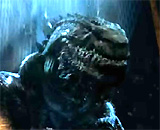 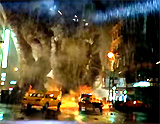 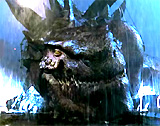 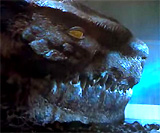 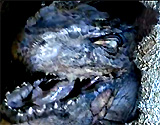
|
||||
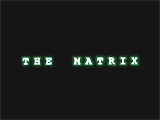 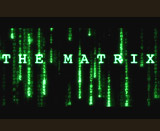  
|
A series of hyperkinetic thrillers (not official disaster films) from the Wachowski Brothers examined the nature of reality in the external world - seemingly uncertain, in which reality was a computer simulation (the Matrix), and the actual Earth was scorched. The films were set in the near future (actually about 200 years later, around the year 2199). Evil machines kept humans pacified and fooled by the illusion that mimicked everyday reality. The character of computer programmer/hacker Thomas Anderson (Keanu Reeves), with screen-name alias Neo - was introduced. He was destined to be the messianic one to save the world and free humans. Rebel warrior Morpheus (Laurence Fishburne) explained to Neo how life on Earth was covered over by the Matrix - a completely-simulated reality or facade. The Matrix was described as a computer-generated dream world built in order to keep human beings and their minds controlled and manipulated. It had been created by malevolent, cyber-artificial-intelligent sentient beings that enslaved humans by imprisoning their minds and bodies:
On the street, Morpheus introduced Neo to more details about the Matrix:
Then he described the enemy, agents or sentient beings/programs:
Morpheus then showed, on a television screen, the difference between the dream world -- "the world as it was at the end of the 20th century" and "the world as it exists today." It was a stark contrast - the latter view was composed only of crumbled buildings and shrouded, darkened and stormy skies ("Welcome to the 'desert of the real'!"). He further explained how in the 21st century, humans had waged a war against AI (artificially-intelligent) machines that they had themselves created. When humans blocked the machines' access to solar energy (and caused a 'nuclear winter'), the machines had begun to enslave and harvest the humans' bioelectricity for power - in effect, humans had become batteries. In the film's conclusion, Neo - who had been unplugged from being an enslaved human - joined the Rebels in hacking into the Matrix. In a final standoff, he was confronted by the powerful sentient program Agent Smith(s), and finally realized that he had the power to perceive and control the Matrix, through his understanding of the true nature of the simulated reality. |
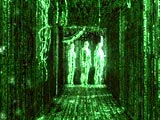  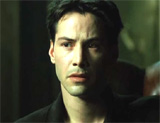 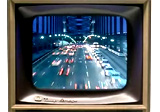 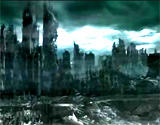 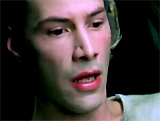 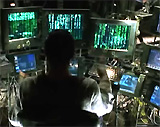 
|
||||